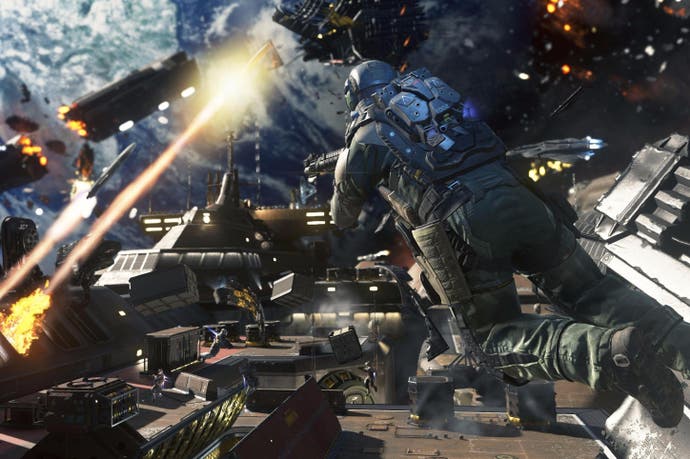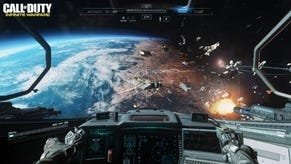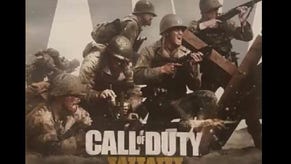Call of Duty: Infinite Warfare review
To infinity but not quite beyond.
Let's pretend, for a moment, that the phrase 'Infinite Warfare' actually means something. Let's pretend that it isn't just the usual flavour text, tacked onto the title to mark a studio's painful rebirth, while sparing older gamers the vertigo of actually reading the words 'Call of Duty 13'. Let's pretend that it is something tangible. Even navigable. The mathematical symbol for infinity is a figure of eight turned on its side. I gaze at that symbol and after a while, I begin to see something I recognise. A single, looping path, belted at the waist to create an intersection and thus, blind spots and flanking opportunities - a terrain for engagement which ensures a combatant can strike out at whim and find their way inexorably to a foe.
I see the bare vertebrae of an Infinite Warfare multiplayer map, a combat centrifuge in which every detail serves to situate and direct, propelling you onward and around as if by magnetism. I see Frost, with its alcoves occupied by worker droids (whose ceaseless plodding I still occasionally mistake for hostile activity) and its euphoric wall-running routes, whirling you down the flank like a pinball along a rail. I see Frontier, with its two main corridors arranged cross-wise atop each other, its low ceilings nudged by free-falling corpses. I see Breakout, a mountaintop lock-up whose transparent cells gaze out over miles of snow, scree and cloud - the designer's joke perhaps being that a prison remains a prison, whether you're scurrying along the outside of the cell with rifle in hand or staring glumly through the glass.
These are environments that instil a strange mixture of boldness and anxiety. Yes, there is no possibility of getting lost (should you ever lose your bearings, maps are now divided into zones that are named on the HUD), but by the same token there is nowhere to hide. Wherever you are in an Infinite Warfare map - save for when playing the surprisingly restful new mode Frontline, a TDM variant which gives each side a fixed spawning area in which your lifebar is dramatically extended - there is almost always somebody coming up behind you.
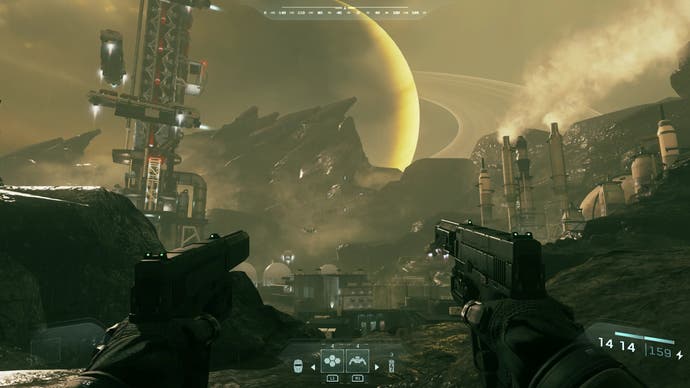
You'll lay the odd ambush, of course, fleeing around a corner only to twirl on your heel and drop to prone, but to linger is generally to die. It's the concept of performative masculinity at its most vicious and insecure - do or be done to, run or be run down, played out to perpetuity in a hail of plasma grenades, homing energy beams and spiralling air-to-surface missiles.
It's also a world away from Call of Duty 4: Modern Warfare, which has been controversially remastered as part of the Infinite Warfare package. While erected around similar principles of readability and fluidity, Modern Warfare multiplayer is a game for opposing armies - the participants are slower, camouflage is often decisive, grenades find victims a little more easily and campers are a real terror. A decade down the line, Call of Duty has become a game for show-offs, with a daredevil move-set of wall-runs, boost-hops and knee-slides gleaned from study of eSports POTGs and YouTube killstreak videos. As in any gladiatorial sport, it's not about simply beating the other side but upstaging them. Teamwork is still paramount, and a disciplined squad will get the better of a gaggle of talented randoms most of the time, but the rewards for virtuoso performers have never been greater.
This was also true of Treyarch's Call of Duty: Black Ops 3, whose move-set - itself a spin on the exosuit abilities from Call of Duty: Advanced Warfare - is preserved here more or less unchanged. That Infinite Warfare is often just Black Ops 3 in space is probably the most damaging complaint one can make, though the plot's nauseating habit of preaching about heroic sacrifice and the greater good runs a close second. But it also diverges from Black Ops 3 in provocative ways, and at the heart of all that is each game's attitude to technology.
Channelling the spirit of Deus Ex, Black Ops 3's campaign deals with the anxieties roused by the development of cybernetic implants and prosthetics. Its technology is liberating but subversive, a Mephistopheles that can be bargained with but not controlled. Infinite Warfare dispenses with all those misgivings at a stroke, even as its first main mission, in which you weather an unprovoked attack on the Earth's space navy over Geneva, reverts to the simplistic morality of the franchise's World War 2 outings. For this game technology is by and large a benign entity, a source of exhilaration and innocent empowerment. Think cruisers dropping out of hyperspace like a fist through a door, the gathering thunder of a dropship's launch boosters and more-human-than-human robot allies who are always ready with a quip or bromantic gesture.
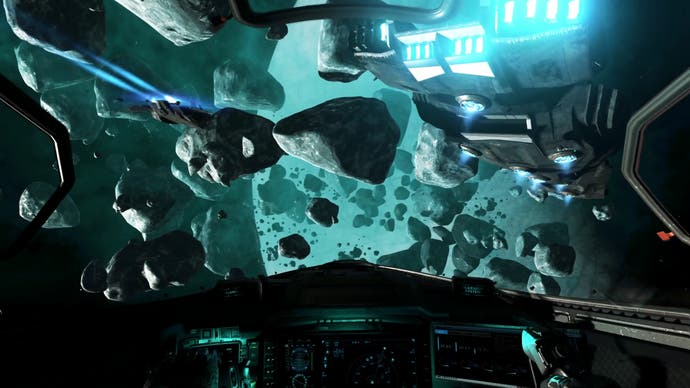
Moreover, where Black Ops 3's campaign eventually tore itself apart over the implications of cyborg tech, exposing its own level design for a malicious, fallible mechanism, Infinite Warfare's rather more dependable gizmos mirror the well-drilled elegance of its campaign flow. The missions themselves (31 in all, including nine optional quests) aren't remarkable - QTE-sprinkled corridor shoot-outs, bowl-shaped arena battles and infiltration sequences such as a zero-G sniping escapade that compares loosely to Modern Warfare's "All Ghillied Up", though the staging isn't nearly as evocative. You'll also get to escort giant mechs, breach rooms in slow-mo and roam a hangar bay Far Cry-style, knifing guards and disabling robot storage pods to give yourself an edge in the subsequent firefight.
The sci-fi element isn't entirely a question of what kind of planet is on the horizon, or whether the gun in your hand goes "zap" rather than "bang". During the assault on the Moon facility, for example, you can shatter ceiling-high windows to eliminate groups of attackers in one fell swoop, and the campaign's many dogfights are tremendous, even if all you're really doing is locking onto angry metal objects till they pop. For much of Infinite Warfare's 5-6 hour length, however, you could be forgiven for thinking it resolutely Earthbound. Indeed, the game is something of a backward step even for good old ground-based Call of Duty. The presence of secret chambers that house rarer guns creates a little more incentive to roam, but save for a hack module that lets you seize manual control of enemy 'bots, the abilities are strangely humdrum.
What is remarkable about Infinite Warfare's story is how deftly you're fed through the stage machinery - from your own capital ship's map table through the armoury to the launch bay, out into the scenario at hand and back again on a soothing conveyer belt of protocol and comms chatter. There are very few abrupt changes of time or perspective, and all the loading breaks are masked by semi-interactive dropship launching sequences, pre-rendered cutscenes or in-engine dialogue. It's as sinuous a structure as the multiplayer map design, a steady ebb and flow that feels like Infinity Ward fixing the suspension after Treyarch drove the series off-road.
I was genuinely surprised, on completing the game, to discover just how many individual missions I'd completed without realising. But if the campaign takes you places without effort, it never really takes you anywhere incredible, or inspires much thought beyond a somewhat belated admiration for how cleanly the moving parts are meshed. Black Ops 3 may have been convoluted and soggy with self-loathing, but it was at least arrestingly bonkers, and a story that found ways of expressing its misgivings through mechanics and structure. Infinite Warfare's offering goes down much more easily but, the script's brazen recruitment poster politics aside, I'm already struggling to recall the taste.
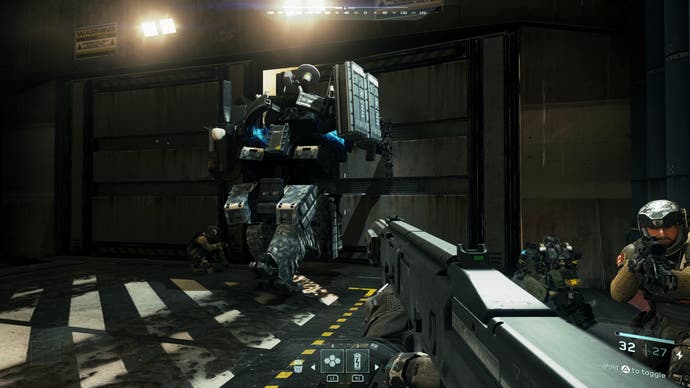
It's a shame when you consider the strength of this year's Zombies Mode, which strikes more of a balance between the campaign's too-silky finish and the desire for real invention. Where Black Ops 3 plumped for a sultry vaudeville labyrinth, the latest spin on World at War's signature mode takes place in a sci-fi theme park, to which a quartet of washed-up actors are magically transported by a malevolent cult film director.
It's an appealing setup for the armchair developer, because it's effectively one generation of environment designers paying tribute to the work of another - and a solid foundation for a more exploration-driven mode like Zombies, because theme park equals rides, and rides equals variety. Among the attractions are a hellish carousel that'll gobble up any walkers nearby, neon water fountains that launch players right across the map, a pair of gigantic motorised jaws and an on-rails shooting gallery with pop-up cardboard gremlins (plus the odd exploding clown).
As ever with Zombies, there's a playfulness and a geeky ingenuity to this side of the game that you won't find anywhere else. Infinity Ward has also fashioned a load-out system of sorts, with up to five perk cards that are activated one by one during play, but the big draw of Zombies remains wandering the map poking stuff to see what it does - a twee robot who'll trundle around issuing challenges once you recover his head, a disco ball that will bring out the John Travolta in any passing corpse.
If Zombies is still a work of immense whimsy, competitive multiplayer has taken a turn for the faceless. Last year's vaguely personable comic book avatars are gone, replaced by six oppressively macho exosuits, or RIGS - huge-shouldered demolition balls wrapped in reverb and ribbon cable that seem massy enough to shatter rock with the wind of their passage, till you catch a bullet and realise that they are, in fact, as frail as sugar frosting.
As with Black Ops 3's Specialists, each RIG is a mix of active Payload, charged up over time during like a MOBA's ultimate, and passive traits, both chosen alongside your weapons, accessories, grenades and perks. The line-up being smaller, the ability pool per avatar is deeper this time around, and there are some spicy combinations to unearth.
The Synaptic RIG boasts a payload that turns its arms into a pair of SMGs with hefty aim assist - a trick that, when paired with a trait that speeds you up for every player you kill, makes this RIG an unanswerable force on maps with short sightlines. The lumbering Merc can switch to a riot shield in order to bully through positions, while the Warfighter can activate Combat Focus to double its scorestreak rewards. The payloads and traits are varied and satisfying to tinker with, though hardly without precedent. It's hard to deploy, say, the FTL's teleport dash or the Stryker's Gravity Vortex without thinking of Call of Duty's new in-house rival Overwatch, which renders up a similar mixture of combat archetypes with vastly more charm.
The proper comparison here isn't Overwatch, though - it's Bungie's Destiny, and in particular, Bungie's miraculous ability to keep people plugging away for loot despite smugly obfuscatory quest mechanisms, a much-berated RNG and some decidedly uneven post-launch support. On top of the usual player ranks, gear unlocks and Supply Drops that can be either earned in-game or bought, Infinite Warfare introduces a weapon crafting system, allowing players to convert a new resource, salvage, into uncommon, rare and epic versions of guns that are endowed with exotic traits.
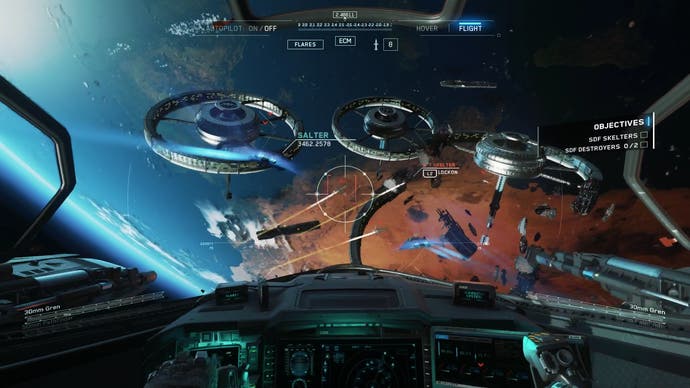
There's a sniper rifle that briefly hides friendlies from radar when you land a kill, an SMG that applies a random perk on respawn and a shotgun that causes hearing loss, among other eccentric specimens. Salvage is handed out (very sparingly) by new NPC guilds, styled as mercenary teams working for the story's factions. As with Destiny's NPC bigwigs, you can set and carry out match assignments (eg kill X with Y) to boost a faction's loyalty, unlocking special guns and gear. It's a diverting additional layer for a component that is already sagging under the weight of things to tweak, but in the absence of background lore or social features, it's hard to imagine the pick of Infinite Warfare' arsenal enjoying quite the same mystique as a Gjallarhorn.
Call of Duty is often branded a boring series, and when I think about how many times I've summoned a UAV, unlocked a foregrip that lessens recoil or rushed into the open to claim a Domination point, it's a struggle to disagree. But I think that's also to overlook the wood because you've taken cover behind a tree. As an on-going project, Call of Duty fascinates (and at times, revolts) in a way few of its competitors can. It's a billion-dollar war machine that must reinvent itself each year while staying exactly the same, a formula that has become as ubiquitous as football but which is tasked, unlike football, with the problem of sequels.
Above all, it's an intriguing series to return to because it's such a knotty tug-of-war - a largely friendly but sometimes savage battle of wills between Infinity Ward, Treyarch, Sledgehammer and their supporting studios, to say nothing of eSports or the rowdier kind of fan. Impeccably refined to the point of tedium, Infinite Warfare isn't my favourite Call of Duty by a long shot, but viewed as a dignified response to Black Ops 3's apocalyptic excesses, it is quietly engrossing. And who knows how Sledgehammer will follow on from it in 2017? If this isn't quite a game of boundless possibility, that only means there's room to advance.
